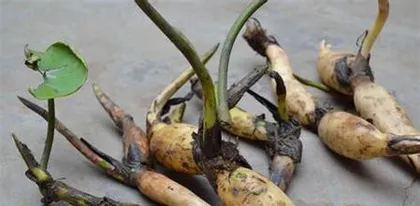As an ancient crop, the history of lotus root in China can be traced back to the Shang and Zhou dynasties, 3000 years ago, and it remains an important part of people's dietary life to this day. With the increasing demand for a healthy diet, more and more people are trying to grow lotus root at home to enjoy the deliciousness and health benefits of their own harvest. How can you successfully grow lotus root at home? Next, we will provide you with a detailed introduction.

Understanding the Growing Environment of Lotus Root
Before starting to grow lotus root, we need to understand its required growing environment. Generally, lotus root grows in a warm and humid environment. The suitable temperature is between 20°C and 25°C, and the soil moisture should be controlled between 60% and 70%.
Choosing the Right Season for Planting
Lotus root is a crop that can be planted in all four seasons, but the best seasons for planting are spring and autumn. In spring, the temperature is suitable, and lotus root grows rapidly. In autumn, lotus root can better accumulate nutrients.

Selecting Suitable Soil
Lotus root has relatively high requirements for soil. Generally, it likes soft, fertile, and well-drained soil. When selecting soil, you can add a moderate amount of organic fertilizer to increase soil fertility.
Selecting Healthy Seeds
Selecting healthy seeds is one of the keys to successful lotus root planting. You can buy them from local farmers' markets or seed stores, and you need to pay attention to selecting seeds that are well-packaged, free from insect eggs, and not moldy.
Soaking the Seeds
Soaking the seeds can make them germinate and take root faster. Soak the seeds in clear water for about 24 hours, then take them out and let them dry.

Applying Fertilizer Appropriately
During the growth of lotus root, it is necessary to apply fertilizer in appropriate amounts. Generally, you can fertilize once every 10 to 15 days, using a moderate amount of organic fertilizer or compound fertilizer.
Controlling Water
The growth of lotus root requires sufficient water, but too much water can cause root rot. When watering, you can water at different times and in batches. Each time you water, let the soil fully absorb it.
Paying Attention to Pest and Disease Control
Lotus root is susceptible to various pests and diseases, such as leaf spot, downy mildew, and flea beetles. During the growth process, you need to discover them in time and take effective preventive and control measures.
Pruning Appropriately
During the growth period of lotus root, it is necessary to prune appropriately. You can prune the stems and leaves into a circular shape to promote the concentration and transport of nutrients, and at the same time, control the growth of stems and leaves.
Controlling Density
Lotus root is a relatively cold-tolerant crop, but it has high requirements for space. Therefore, when planting, you need to pay attention to density control. Too high a density will lead to poor growth of lotus root, affecting the yield and quality.
Maintaining a Suitable Temperature
Lotus root needs a suitable temperature to grow well. In hot summer weather, you can take measures such as shading or spraying water to maintain a suitable temperature in the lotus root growing environment.
Timely Harvesting
After the growth period of lotus root ends, it should be harvested in time. When harvesting, select lotus roots that are relatively thick and plump. Be careful not to damage the skin of the lotus root.
Storing Lotus Root
The harvested lotus root needs to be stored in time to prevent spoilage. You can place it in a cool, dry place, such as a cellar or a storage room.
Processing and Utilization
The harvested lotus root can be processed and utilized in various ways, such as slicing, making soup, or drying into lotus root chips. Choose according to personal taste and needs.
Through the detailed introduction of lotus root planting and maintenance, we can understand the key techniques and precautions that need to be mastered for planting lotus root. In actual operation, you need to adjust according to the local climate, soil, and light conditions in order to create a healthy and productive lotus root garden.